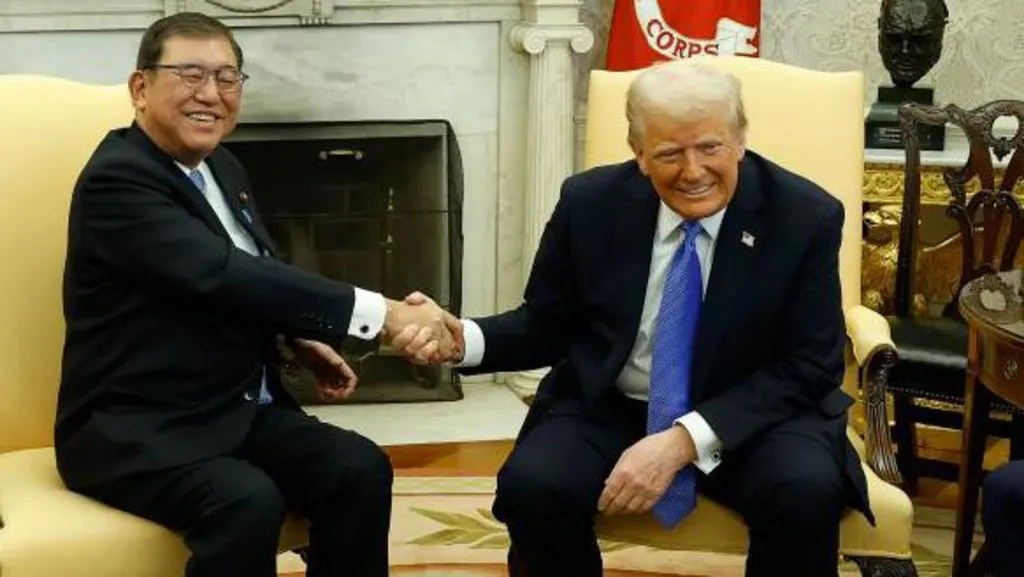Trump and Japan’s PM Shigeru Ishiba A New
Chapter in U.S.-Japan Relations
 By Kevin
By Kevin
The recent meeting between former U.S. President Donald Trump and Japan’s Prime Minister Shigeru Ishiba turned out to be a surprisingly smooth and productive encounter, leaving many people in Japan and the U.S. optimistic about the future of their relationship.
For Ishiba, the stakes were high. At home, he faced criticism for being too quiet and not charismatic enough to handle someone as bold and unpredictable as Trump. Many doubted whether he could manage the diplomatic pressure. But Ishiba rose to the occasion, proving his critics wrong and solidifying Japan’s alliance with the U.S.
A Plan Built on Preparation
Knowing Trump’s reputation for being a tough negotiator who loves flattery and big economic wins, Ishiba and his team worked tirelessly to prepare for the meeting. They held “Trump study sessions,” looking into his style of communication, his priorities, and even getting advice from Akie Abe, the widow of former PM Shinzo Abe, who had famously built a strong rapport with Trump.
Ishiba came prepared with a strategy: keep things simple, focus on areas where both nations could benefit, and avoid unnecessary tension. And it worked.
Economic Deals That Benefit Both Countries
One of the biggest moments of the meeting came when Ishiba announced that Japan would invest $1 trillion in the U.S., with Japanese automakers expanding their operations and Japan increasing imports of American liquefied natural gas (LNG).
Trump, never one to miss an opportunity to celebrate a big win, highlighted plans for Japanese investments in U.S. Steel. For both leaders, these deals were a way to show their people back home that they were focused on jobs and economic growth.
For Ishiba, this move demonstrated Japan’s commitment to strengthening ties with the U.S. For Trump, it was another opportunity to boast about his ability to “make deals.”
Easing Worries About Tariffs
Many in Japan were nervous going into the meeting. Trump has a history of surprising allies with unexpected tariffs, and Japan worried it might be next. However, tariffs weren’t the focus this time. Instead, both leaders emphasized their shared goals, especially when it came to trade and defense.
This shift in tone helped reassure Japan and other U.S. allies that the relationship between the two nations remained strong.
Balancing China’s Influence
China was an inevitable topic in the meeting. As Japan’s biggest trading partner and a growing military threat, China poses both opportunities and challenges for Tokyo. Ishiba walked a careful line, ensuring Japan remained aligned with the U.S. on security concerns while avoiding direct confrontation with Beijing.
One key area of cooperation was Japan’s ambitious plan to double its military spending by 2027. This move reflects growing concerns over regional security, especially regarding North Korea and China. The U.S. welcomed Japan’s increased focus on defense, seeing it as a sign that Tokyo is ready to play a bigger role in the Asia-Pacific region.
A Personal Victory for Ishiba
At home, Ishiba had been under intense pressure. Many doubted whether he had the skills to handle such a high-profile meeting. But by focusing on preparation, humility, and shared goals, Ishiba managed to not only hold his own but also secure meaningful outcomes for both countries.
Japanese media, which had been skeptical of Ishiba, quickly praised his performance. For someone often criticized as being too reserved, this meeting marked a turning point in how he is perceived as a leader.
A New Era for U.S.-Japan Relations?
After the meeting, Ishiba called it the beginning of a “golden era” in U.S.-Japan relations. While that may be a bit optimistic, there’s no doubt that the meeting strengthened the bond between the two nations.
In a time of growing challenges in the Asia-Pacific—from North Korea’s nuclear ambitions to China’s rising influence—the U.S.-Japan alliance remains critical. Ishiba’s ability to navigate this meeting successfully not only benefits Japan but also ensures that this partnership will continue to play a key role in regional stability.
For now, Ishiba has silenced his critics and proven that Japan can remain America’s closest ally in Asia. Whether this “golden era” truly materializes remains to be seen, but one thing is certain: both leaders left the meeting stronger than they entered it.


0 Comments